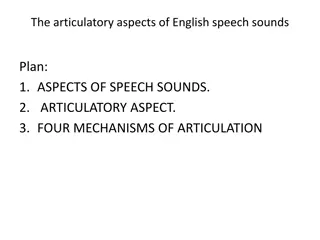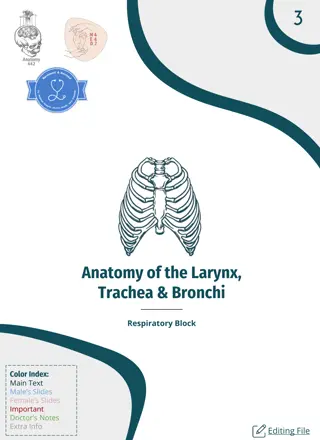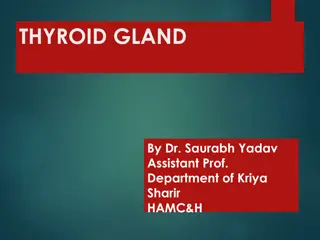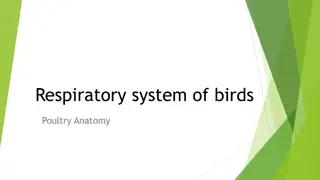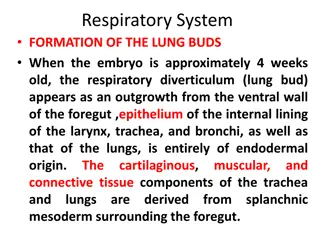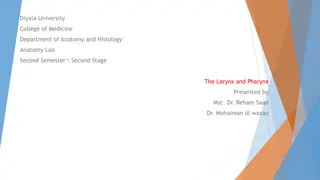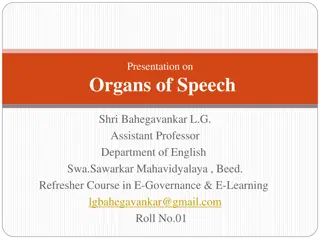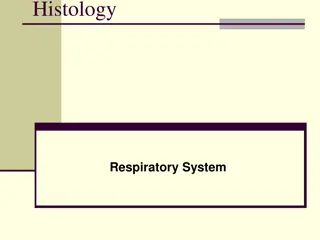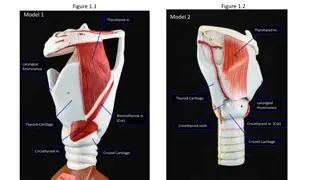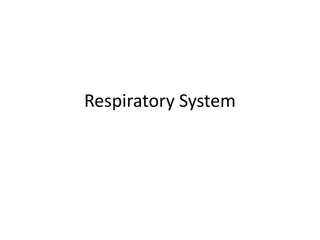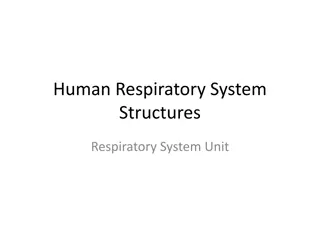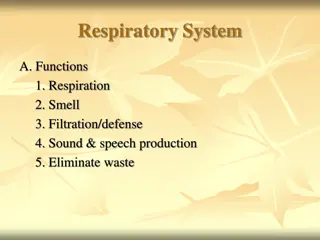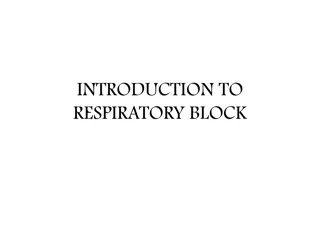Anatomy and Physiology of the Larynx: Overview and Cartilages
Exploring the anatomy and physiology of the larynx, this content discusses the location, movements, and cartilages of the larynx. Details on the unpaired (thyroid, cricoid, epiglottis) and paired (arytenoid, corniculate, cunieform) cartilages are provided, along with their functions and characterist
9 views • 17 slides
Understanding Articulatory Aspects of English Speech Sounds
Speech sounds are integral to language, with articulatory, acoustic, auditory, and functional aspects. Articulation involves mechanisms like the power, vibrator, resonator, and obstruction mechanisms. The power mechanism includes the respiratory system, while the vibrator mechanism operates through
10 views • 10 slides
Anatomy of the Larynx, Trachea, and Bronchi: Respiratory System Overview
The larynx, trachea, and bronchi are vital structures of the respiratory system with distinct functions and anatomy. The larynx houses vocal cords, aids in breathing, voice production, and swallowing. It is interconnected with major arteries, veins, and nerves in the neck. The trachea extends from t
12 views • 19 slides
Understanding the Thyroid Gland: Functions and Hormone Synthesis
The thyroid gland is a vital endocrine gland located below the larynx, responsible for producing thyroid hormones essential for regulating metabolism. This gland consists of follicles lined with follicular cells, producing thyroglobulin and thyroid hormones T3 and T4. Iodine plays a crucial role in
0 views • 40 slides
Anatomy of the Respiratory System in Birds: A Detailed Overview
The respiratory system in birds, including poultry, consists of various components such as nostrils, nasal cavities, larynx, trachea, syrinx, air sacs, and lungs. Each part plays a crucial role in respiration, with unique features adapted to avian physiology. Understanding the anatomy of the avian r
1 views • 19 slides
Development of the Respiratory System in Human Embryos
The formation of the lung buds, larynx, trachea, bronchi, and lungs in human embryos involves complex processes where various structures develop from different tissue origins. The lung buds arise from the ventral wall of the foregut, while the larynx, trachea, and bronchi epithelium are of endoderma
7 views • 19 slides
Comprehensive Overview of Head and Neck Cancer by Dr. Swati Lambor, ENT Consultant
Cancer of the head and neck region poses a significant threat, with various types of tumors affecting areas like the nasal cavity, paranasal sinuses, mouth, larynx, salivary glands, and thyroid. Dr. Swati Lambor, a skilled ENT consultant at Manipal Hospital in Goa, sheds light on the causes, progres
0 views • 72 slides
Anatomy of the Pharynx: Structure and Function
The pharynx is a musculomembranous tube that connects the nasal and oral cavities to the larynx and esophagus. It is divided into three parts: nasopharynx, oropharynx, and laryngopharynx, each with unique features and functions. Muscles like pharyngeal constrictors and palatopharyngeus play a crucia
0 views • 31 slides
Understanding the Organs of Speech: An Insightful Presentation
Delve into the fascinating world of organs of speech with this comprehensive presentation by Assistant Professor Shri Bahegavankar L.G. Learn about the respiratory system, phonatory system, and articulatory system, exploring the functions of the lungs, muscles of the chest, windpipe, larynx, and voc
0 views • 29 slides
Overview of Mammalian Respiratory System Histology
The respiratory system in mammals functions to warm, humidify, and cleanse the air as it travels from the nostrils to the lungs. It comprises the nasal cavity, pharynx, larynx, trachea, bronchi, and bronchial tree. The epithelial linings vary in different parts, containing specialized cells and glan
0 views • 14 slides
Understanding the Respiratory System Components and Functions
The respiratory system consists of two primary subdivisions: the Air Conducting portion and the Respiratory portion. The Air Conducting portion includes nasal cavity, naso-pharynx, larynx, trachea, bronchi, bronchioles, and terminal bronchioles, providing a pathway to and from the lungs while condit
0 views • 12 slides
Anatomy of the Larynx: Detailed Illustrations and Muscle Actions
Detailed illustrations and descriptions of the anatomy of the larynx, including structures such as the thyroid cartilage, epiglottis, vocal folds, and muscles like the cricothyroid and posterior cricoarytenoid. The images depict the laryngeal landmarks, ligaments, and nerves, providing a comprehensi
0 views • 5 slides
Understanding the Respiratory System and Its Functions
The respiratory system is vital for gas exchange in the body, involving processes like pulmonary ventilation, external and internal respiration. It includes organs like the nose, pharynx, larynx, and trachea, which help in conducting air to the alveoli. This system facilitates the exchange of oxygen
1 views • 14 slides
Understanding the Breathing System in Humans
Explore the intricacies of the human breathing system, including the role of carbon dioxide in gaseous exchange. Test your knowledge with interactive quizzes and learn about the functions of different respiratory components such as the larynx and trachea. Dive into topics like breathing rates, gas e
0 views • 50 slides
Comprehensive Visual Guide to Respiratory System Anatomy
Explore a vivid collection of images detailing various components of the respiratory system, including the nasal cavity, conducting zone, vocal cords, larynx, and more. These educational resources are licensed under Creative Commons Attribution 3.0, allowing you to utilize them for presentations and
0 views • 13 slides
Overview of Laryngeal Inflammations in Pediatric Patients
This comprehensive overview covers various inflammations of the larynx in pediatric patients, including laryngotracheitis, supraglottitis, diphtheria, chronic non-specific laryngitis, tuberculosis (TB), scleroma, and voice-induced disorders. It discusses causes, symptoms, diagnostic features, treatm
0 views • 10 slides
Understanding Stridor: Causes, Symptoms, and Grades
Stridor is an abnormal high-pitched sound caused by disrupted airflow in the larynx or windpipe, often affecting children. It can indicate various underlying issues based on the type of stridor present. Grades of stridor range from mild to severe, with different treatment approaches for each. Infect
0 views • 31 slides
Exploring the Human Respiratory System Structures
Delve into the intricate structures of the human respiratory system, from the essential organs like the lungs and diaphragm to the pathways such as the nasal cavity, mouth, pharynx, and trachea. Learn about the functions of key components like the epiglottis, larynx, bronchi, bronchioles, and alveol
0 views • 12 slides
Overview of the Respiratory System Functions and Anatomy
The respiratory system has vital functions such as respiration, smell, filtration/defense, sound & speech production, and waste elimination. It consists of external (root, bridge, apex, and nostrils) and internal components (nasal cavity, pharynx, larynx). The nose/nasal cavity provides an airway fo
0 views • 37 slides
Comprehensive Overview of Respiratory Block for Medical Students
This respiratory block introduces students to the anatomy, histology, muscles involved in respiration, embryology, radiological anatomy, and management of respiratory disorders. It covers topics like the nasal cavity, pharynx, larynx, trachea, bronchi, lungs, pleura, bronchial tree, and mediastinum.
0 views • 23 slides

